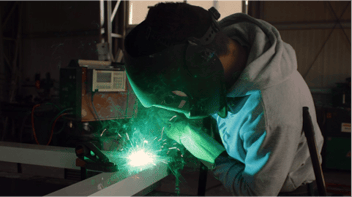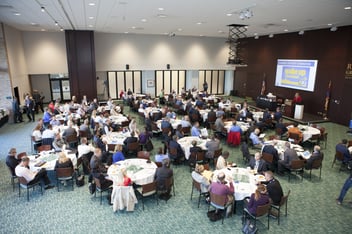Manufacturers: 6 Key Questions to Assess Your Employee Engagement
 How engaged are your employees?
How engaged are your employees?
Take a closer look, since manufacturing workers are the least engaged of all major occupations, according to the Gallup State of the American Workforce report. Only 25% of manufacturing employees are considered engaged.
Forbes reports that engaged employees create less turnover, 21% greater profitability, 17% higher productivity, and 10% higher customer ratings than those who are considered disengaged.
Small- to mid-sized manufacturers may have the upperhand, knowing larger companies can struggle with engagement issues more than smaller players. Employees in large companies (1,000+ employees) report that they feel they may not make an impact on the company’s mission.
Regardless of the size of your business, fostering a culture of engagement can start at the top and radiate across the organization. Employees supervised by highly engaged managers are 59% more likely to be engaged than those supervised by actively disengaged managers.
Engagement is vital to your manufacturing business’ health; here are 6 questions to assess its current status.
Why Does Engagement Matter?
Across the entire American workforce, approximately one-third of all employees are engaged at work. Engaged employees love their jobs and actively work to help their company succeed.
Engaged employees are:
- More likely to practice safety in the workplace and are more productive.
- More likely to stay with the organization, reducing turnover and the associated costs.
- More likely to build strong relationships with customers.
- More effective brand ambassadors.
>>>Related Resource: 3 Steps to Help Build and Retain Engaged Employees
6 Questions to Assess Your Employee Engagement
Before taking action to address engagement problems in your organization, ask the following questions to uncover the biggest engagement problems and opportunities for improvement.
1. Can workers connect their job to the organization’s mission or purpose?
Does your organization have a mission statement?
A mission statement defines your goals, values, and vision for the company. It acts as the “true north” for employees to connect their work to.
Develop an honest, meaningful mission statement about the value your company brings to customers, employees, the world, or whomever else it benefits. Employees can find a sense of purpose by connecting their work back to the mission. When every work activity relates to that purpose, it brings meaning to that employee, regardless of how mundane or grandiose it may be.
2. Do your managers view themselves as coaches?
The manufacturing floor and office building requires managers to coach their team. Unlike annual performance reviews, coaching is the day-to-day interaction between employees and leaders. It includes both positive feedback and ways to improve—in real time.
Notably, the engagement level of executives is 45%, for managers it’s 29%, and for employees without reports it’s even lower. Because employees with highly engaged managers are much more likely to be engaged, a trickle-down effect can result from creating a coaching culture at the top. For companies, this creates a culture of trust, collaboration, and appreciation between lower-level employees and upper management.
If managers give ongoing feedback and effectively coach their teams, the meaningful feedback inherently increases performance and makes workers more excited to perform.
3. Is an effective onboarding process in place?
Currently, only 12% of employees believe their organization does a great job of onboarding new employees. Can you step up this process?
Though it can feel tedious to repeat the same process for each new hire, onboarding helps set the employee up for success. Effective onboarding must remove employee uncertainty by answering:
- What are my core responsibilities?
- What is expected of me?
- Who can I go to whenever I have a question?
It should also include all necessary training, related to the job itself, company processes, and all other information. Much of this information is second nature to seasoned employees, but likely foreign to new hires.
Just as first impressions are critical in social settings, creating a positive experience for new hires on day one sets the course for a positive relationship with your company.
4. Are employees in jobs that fit their skill sets?
A majority of employees—60%—say the ability to excel in their job functions is “very important” to them. Starting at the recruiting and hiring phase, are expectations set clearly on what the role will involve? Employees are most engaged and perform best when their talent, skills, and knowledge align with their responsibilities.
5. Do workers know what’s expected of them?
It sounds like a given, but only six in 10 manufacturing workers know what’s expected of them.
Do you have a program for benchmarking and reviewing employee performance? Consider how managers can meet regularly with employees to discuss expectations, goals, and performance. This practice increases accountability and, with clearer expectations, enables employees to be more autonomous.
6. How are high-performing employees recognized?
At your company, how is performance recognized and/or rewarded?
Today, few employees feel their work is encouraged. Assuming you’re paying market value, an organized program or monetary prize may not be necessary to recognize top performers— rewarding employees is about much more than just money. Rather, publicly praising performance as it occurs increases individual encouragement and motivation, and can cause a cascading effect for the company culture.
In conclusion, according to the Gallup Poll:
“The American workforce has more than 100 million full-time employees. One-third of those employees are what Gallup calls engaged at work. They love their jobs and make their organization and America better every day. At the other end, 16% of employees are actively disengaged — they are miserable in the workplace and destroy what the most engaged employees build. The remaining 51% of employees are not engaged — they’re just there.”




